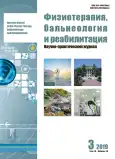The effectiveness of the combined use of RF therapy and laser technology in the correction of involutive changes in the skin of the face
- Authors: Kruchinskaya M.G.1, Manturova N.E.2, Stenko A.G.1
-
Affiliations:
- JSC “Institute of Plastic Surgery and Cosmetology”
- Pirogov Medical University of the Ministry of Health of the Russian Federation
- Issue: Vol 18, No 3 (2019)
- Pages: 145-153
- Section: Original studies
- URL: https://journals.rcsi.science/1681-3456/article/view/62571
- DOI: https://doi.org/10.17816/1681-3456-2019-18-3-145-153
- ID: 62571
Cite item
Full Text
Abstract
Bipolar radio-frequency devices have all the theoretical prerequisites for use in combination with phototechnologies, while the properties of electro-optical synergy are manifested.
Material and method. The study included 125 patients aged 40 to 50 years. Depending on the therapy, patients were divided into 4 groups and subgroups A and B, depending on the identified predictors of the effectiveness of laser therapy.
The results of the study. After applying the combined methods, a more significant improvement in the quality characteristics of the skin was noted: an increase in skin moisture in the 1A group, the corneometry index increased by 24.6%, in the 1st group — by 28.3%, in the 2A group — by 38.9%, in the 2B group — by 37.3%, in the 3A group — by 29.1%, in the 3B group — by 27.5%, in the 4A group — by 38.8%, in the 4B group — by 38.8%; an increase in skin elasticity in group 1A, the Ua/Uf indicator increased by 13.2%, in group 1B — by 13.9%, in group 2A — by 27.9%, in group 2B — by 29.0%, in group 3A — by 14.9%, in the 3B group — by 14.6%, in the 4A group — by 28.2%, in the 4B group — by 28.2%, which was accompanied by a more pronounced decrease in the severity of wrinkles according to profilometry. The use of laser therapy (an erbium or neodymium laser) and microneedle RF therapy contributes to a more significant restoration of the epidermal-dermal structure of the skin, which is confirmed by ultrasound data: the microrelief has improved by more than 3 times compared with monotherapy, the thickness of the dermis is 2.2 times and acoustic density 1.7 times.
Conclusions. Combined methods, to a greater extent than mono-laser therapy, contribute to improving the quality of life of patients according to the dynamics of the LHC index, which decreased in groups 1 and 3 by an average of 47.1% and 44.4% versus 57.8% and 64.3% in 2 and 4 groups, while there was a significant difference in the values of the index of HSCI in groups A and B (p < 0.01). In accordance with the VAS and GAIS indicators, the optimal effect after a course of therapy with preservation of the results after 1 year was achieved in 25/12.5% of patients in group 1A, in 46.7/33.3% in group 1B, 7/37.5% of patients of group 2A, 78.6/71.4% of patients of group 2B, 33.3/20.0% of patients of group 3A, 50.0/25% of patients 3B groups, 58.8/58.8% and 75.0/75.0% in patients 4A and 4B of the group, respectively, which indicates the high efficiency of the combined methods and the persistence of the results.
Full Text
##article.viewOnOriginalSite##About the authors
Marina G. Kruchinskaya
JSC “Institute of Plastic Surgery and Cosmetology”
Author for correspondence.
Email: iphk@iphk.ru
PhD
Russian Federation, MoscowNatalya E. Manturova
Pirogov Medical University of the Ministry of Health of the Russian Federation
Email: iphk@iphk.ru
SPIN-code: 5232-0412
DSc.
Russian Federation, MoscowAnna G. Stenko
JSC “Institute of Plastic Surgery and Cosmetology”
Email: iphk@iphk.ru
Scopus Author ID: 562467
DSc.
Russian Federation, MoscowReferences
- Konovka EP. The use of combined laser effects in reconstructive correction of involutive changes in facial skin: PhD Thesis. Moscow; 2014. 236 р. (in Russ.)
- Yusupova LA. Volumetric modeling using combined fillers based on hyaluronic acid and dextranomer. Injection Methods in Cosmetology. 2016;4:17-19. (in Russ.)
- Ivanova EV. Pathogenetic substantiation of the use of the oxygen-ozone mixture in the correction of age-related skin changes. Abstract of the PhD Thesis. Moscow; 2007. 23 p. (in Russ.)
- Pritzker RN, Hamilton HK, Dover JS. Comparison of different technologies for noninvasive skin tightening. J Cosmet Dermatol. 2014;13:315–23. doi: 10.1111/jocd.12114.
- Zhukova OV, Kruglova LS, Frigo NV. A method of aesthetic correction of involutive changes in the skin of the face. Clinical Dermatology and Venereology. 2018;17(2):114-117. (in Russ.)
- Vachiramon V, Sirithanabadeekul P, Sahawatwong S. Low-fluence Q-switched Nd: YAG 1064-nm laser and intense pulsed light for the treatment of melasma. J Eur Acad Dermatol Venereol. 2015;29(7):1339-1346. doi: 10.1111/jdv.12854.
- Yun WJ, Moon HR, Lee MW, Choi JH, Chang SE. Combination treatment of low-fluence 1,064-nm Q-switched Nd: YAG laser with novel intense pulse light in Korean melasma patients: a prospective, randomized, controlled trial. Dermatol Surg. 2014;40(8):842-850. doi: 10.1097/DSS.0000000000000057.
- Chan CS, Saedi N, Mickle C, Dover JS. Combined treatment for facial rejuvenation using an optimized pulsed light source followed by a fractional non-ablative laser. Lasers Surg Med. 2013;45(7):405-409. doi: 10.1002/lsm.22162.
- Atiyeh BS, Dibo SA. Nonsurgical nonablative treatment ofaging skin: radiofrequency technologies between aggressive marketing and evidence-based efficacy. Aesth Plast Surg. 2009;33:283–94. doi: 10.1007/s00266-009-9361-9.
Supplementary files









